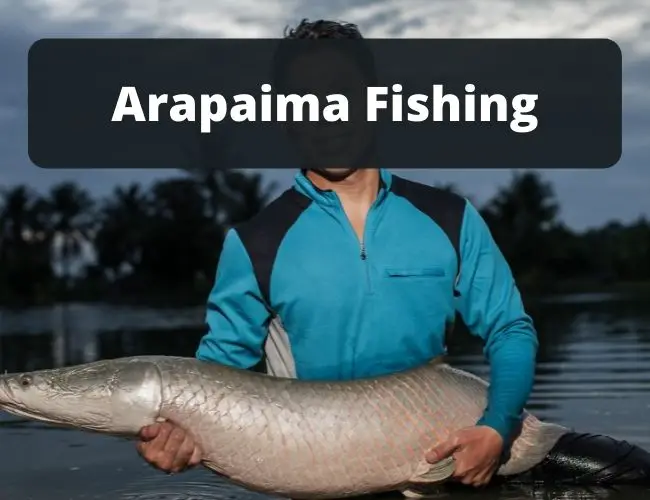Get interesting arapaima fish facts and fishing information. The arapaima also known as the pirarucu is a large, freshwater fish of the Amazon basin. It is the world’s largest species of bony fish and can reach lengths of almost 10 feet (3 meters) and weigh 440 pounds (200 kilograms).
The arapaima can remain motionless without breathing for up to 15 minutes. Arapaima is a large, long fish with scales and fins. They have sharp teeth in their mouths to catch prey.
Their eyes are on top of their head, so they can see prey above them when they swim near the surface of the water. Their tail is round and strong to help them move quickly through the water.
Arapaima can swim very fast, sometimes reaching speeds up to 25 miles per hour (40 kilometers per hour). They use their long fins to move easily through the water and their powerful tail to make quick changes in direction.
Arapaima lives in the Amazon River and its tributaries in South America. They can be found in both saltwater and freshwater environments, but prefer to live in freshwater.
Arapaima is carnivores and eat a variety of prey, including fish, crabs, insects, and other small creatures. They use their sharp teeth to catch prey and swallow it whole.
Arapaima is an important part of the food chain in the Amazon River. They are preyed on by other animals, including larger fish, birds, and reptiles.
Arapaima can breathe air, so they can survive in water that has low levels of oxygen. When they need to breathe, they rise to the surface and take a breath of air. They can remain motionless without breathing for up to 15 minutes.
Arapaima is an important source of food for people in South America. They are often hunted by indigenous people for food and also for their valuable scales, which are used to make jewelry.
These fish are currently listed as Vulnerable by the International Union for Conservation of Nature.
Arapaima has few natural predators, but some animals prey on them, including caiman, birds, otters, and larger fish. They are also threatened by habitat loss and fishing.
Arapaima Fishing
The arapaima is a popular sport fish sought by anglers in the Amazon region. Reports from fishermen indicate that this species can be extremely difficult to catch, often taking over an hour to land.
Arapaima has been known to break rods and lines, and some of the larger individuals can weigh in at over 200 pounds.
Arapaima Fishing Tips
Anglers targeting arapaima often use large lures or live bait, such as fish or frogs. Some anglers use a weighted line and try to drag the fish out of the water.
While others use poles with heavy leaders and drag the fish sideways to wear it down. Many fishermen recommend using a stout rod, preferably over 10 feet in length, and reel with a high drag setting to help battle these fish.
Arapaima Fish Habitat
The arapaima is found only in the Amazon River basin and prefers sluggish, oxygen-poor water. This fish can be found in a variety of habitats, including floodplain lakes, backwater sloughs, and oxbow lakes.
Arapaima Fish Reproduction
The arapaima is a migratory species that spawns in flooded forests during the rainy season. After spawning, the adults migrate back to their preferred habitats.
The eggs and larvae are swept downstream and deposited in quiet water pools where they hatch and develop.
Arapaima Fish Diet
The arapaima is a piscivorous (fish-eating) species that feed on a variety of prey, including fish, crustaceans, and insects. This fish has been known to consume small mammals, such as rodents, and even turtles.
Arapaima Size
The arapaima is the largest species in the family Osteoglossidae and one of the largest freshwater fish in the world.
This giant, air-breathing species can weigh up to 400 pounds and can grow to lengths over 10 feet. These massive predators are known to prey on large animals, which makes them a commercially valuable species.

Arapaima Species
There are 37 subspecies of arapaima, which vary in color and morphology (physical characteristics). Currently, few of these subspecies are held in captive populations. However, some subspecies may be more commercially important than others.
The arapaima is an important species for the subsistence and commercial fishing industries in the Amazon River basin. This giant fish is a popular sport fish, and its flesh is considered a delicacy. Arapaima is also used in aquaculture (aquaculture) for food and as a source of income.
Arapaima in Florida
The largest freshwater fish in North America it has been recorded that these ancient fish can grow up to 10ft long and weigh over 300lbs.
The arapaima is distinctive among fishes because of its anadromous habits. These are types of fish who live out part of their lives in the sea but spawn in freshwater.
They can breathe air and they have a lung-like organ that helps them do this. The arapaima has been known to migrate up to 4,000 miles in a single year to spawn.
Bites from these giant fish can be quite dangerous as they are capable of inflicting serious injuries with their sharp teeth.
Arapaima can be found in the Orinoco and Amazon River Basins in South America. They are considered a critically endangered species due to overfishing and habitat destruction.
Some populations of arapaima have been successfully bred in captivity, however, and there is hope that this majestic fish can be saved from extinction.
Arapaima Behavior
Arapaima’s are schooling fish, and can often be found in groups of 10 or more. They are predatory fish, and will eat anything they can fit in their mouth – including other fish, small mammals, and even birds!
Arapaima Breeding
Arapaima reaches sexual maturity at around 3-5 years of age. After that, they reach breeding maturity at around 4-6 years old.
During mating season, the males construct mating arenas in which they will breed with the females. These areas are usually about 8 feet wide and roughly circular in shape.
Arapaima Scales
Arapaima’s have some of the largest scales of any fish in the world. These scales help protect them from predators and parasites. They also play a role in regulating their body temperature, as they can change color to reflect the surrounding environment.
Arapaima Scales Can Be:
Black on black bodies make them highly efficient at absorbing heat, blue on black bodies reflect solar radiation, and white on black bodies help to retain heat.
Their scales also play a defensive role in that they can be incredibly sharp and protect the fish from predators.
Arapaima has a reinforced body covered with thick scales that provide protection from predators. These scales are covered in a slimy mucus which protects them from infection when they come into contact with the ground.
Arapaima Attack
Arapaima attacks on humans are rare. However, they should be considered dangerous due to their immense size.
arapaima only attack when they feel threatened. They do not attack humans on purpose.
If you find yourself near arapaima in the wild, it is important to avoid splashing and keep your distance.
Arapaima will defend themselves if provoked, using their razor-sharp teeth and powerful jaws or by ramming with their heads in the hopes of knocking down an offending threat.
Arapaima Tongue
Arapaima has a long, thin tongue that they use to catch their prey. They flick their tongue out of the water and into the air to snatch insects or small fish from the surface.
They have a wider mouth at the front, and this allows them to open their mouth wide enough to eat large prey.
Arapaima Water Glands
Arapaima has a special organ called a Weberian apparatus, which is an extension of their vertebrate column. This attaches to sound-producing muscles that vibrate the swim bladder and ear bones.
It amplifies the sounds they make so neighboring fish can hear them from long distances. This helps them communicate with other arapaimas, as well as attract mates.
Biggest World Record Arapaima Caught
The biggest and largest arapaima that was ever caught was 8.3 meters long and weighed over 400 kilograms
It lived in Brazil, Peru, Colombia, Ecuador, and Guyana. Scientists think that the Arapaima is an air-breathing fish.
A rapping of an arapaima can be heard 5 kilometers away underwater. Arapaima’s are very fast swimmers and they live in schools at depths of up to 60 meters. If it wanted to, the arapaima could probably travel 300 kilometers per day.
Baby Arapaima Fish
A baby arapaima is only 10 centimeters long when it’s born and it takes 8 years for it to grow to be 2 meters long.
The baby arapaima grows to get two different types of teeth. One type is used for eating and the other type is used to protect itself when it gets attacked. Arapaima’s eat fish, insects, small mammals, and even small turtles.
Each arapaima has its own unique pattern of scales on its body. These scales are used by scientists to identify different arapaimas.
Baby Arapaimas can live up to 40 years in the wild, but in captivity, they usually only live for 20 years.
When an arapaima gets seriously ill, it goes to the surface of the water to get air. That’s when people can catch them easily. People used to think that the arapaima was extinct in one part of its range because for years and years no one could catch any there.
Interesting Posts:
Conclusion
Arapaimas are interesting fish with many unique features. They are the largest freshwater fish in the world and can be found in the Amazon River.
They eat a variety of things, including small mammals and turtles, and have two different types of teeth. Their scales can be used to identify them, and they can live up to 40 years.
I hope you found this post on Arapaima Fish facts and Fishing Helpful. Please share it.









